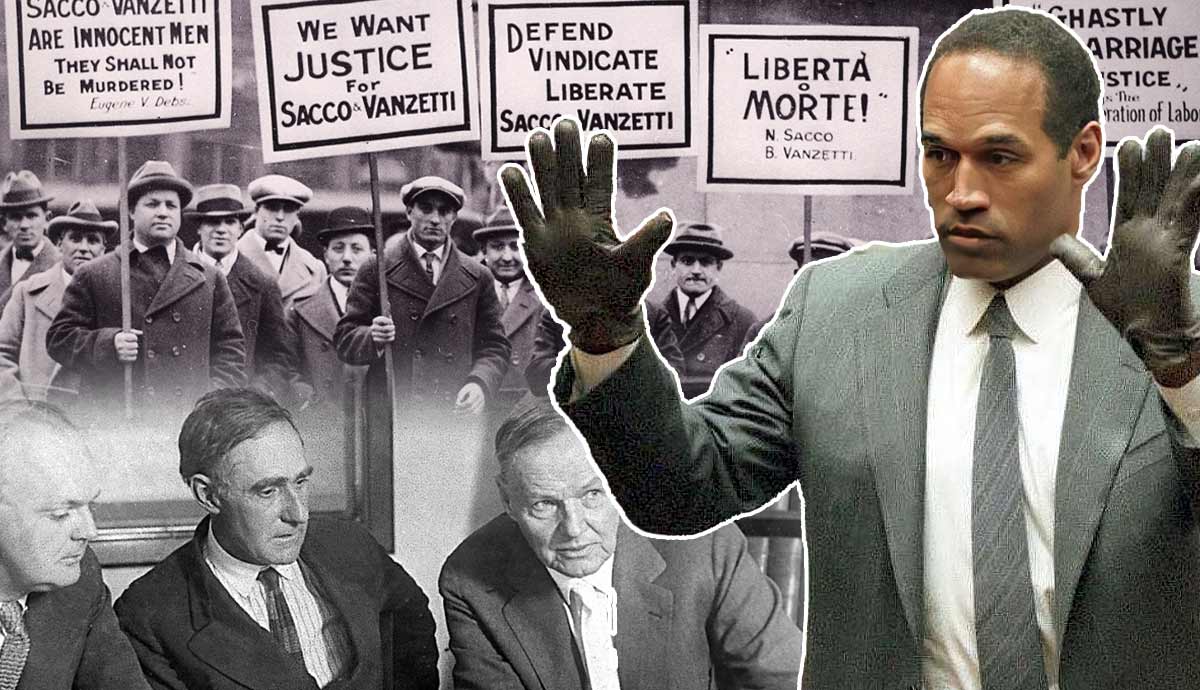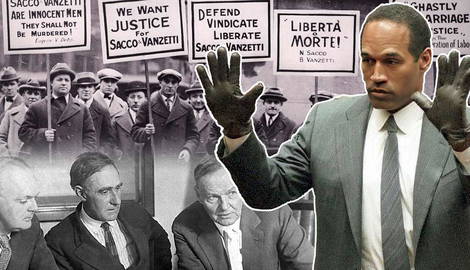
Since the founding fathers, the United States has been home to countless gripping political scandals, sordid murders, and seditious plots whose court cases captured the attention of the American public. With the expansion of mass media technologies such as newsreels and radio and, later, live television, the 20th century became host to several ‘Trials of the Century.’ Often given the moniker by a journalist hoping to stir up excitement and sell more papers, these trials are genuinely unique in their captivation of the public and long-term impact on American culture. Chosen for their unprecedented sensationalism, when someone mentions the most notorious trial of the 20th century, they are likely referring to one of the following cases.
1. The Trial of Sacco and Vanzetti

On April 15, 1920 payroll clerk Frederick Parmenter and security guard Alessandro Beradelli were shot to death at the Slater and Morrill shoe factory in Braintree, Massachusetts and over $15,000 in cash was robbed. Weeks after the murders, Nicola Sacco and Bartolomeo Vanzetti were arrested. Both men were armed and Sacco carried a flyer announcing an upcoming anarchist rally that Vanzetti was slated to speak at. Sacco and Vanzetti were the only arrests made in this case despite the stolen money never being linked to them.
The following, notorious trial is remembered as one marred by unfair practices – a common theme in sensationalized trials – because the judge allowed the prosecution to put forth comments on the men’s political ideologies as evidence. On July 14, 1921, both men were convicted and sentenced to death. In response, public protests erupted throughout the country and the world, with bombs even being set off in New York and Philadelphia, but all attempts for a retrial failed. Sacco and Vanzetti were both executed on August 23, 1927.
These arrests took place in the context of America’s first ‘Red Scare,’ a time period made distinct by the paranoia surrounding communism and radical beliefs. The two men did not have a record of violent crimes but because they were both Italian immigrants with anarchist beliefs, they were targeted. Due to the political backdrop of the case, Sacco and Vanzetti’s trial became a symbol both to Americans who favored isolationism and anti-immigrant sentiment as well as Americans who wanted to fight against it.
2. The Scopes Monkey Trial

In July of 1925, John T. Scopes, a high school teacher in Dayton, Tennessee, was charged with teaching the theory of evolution in his classroom. This was directly against a state law, the Butler Act, that had been passed just months earlier, making it illegal to teach any theory that denies Divine Creation. The Scopes Monkey Trial was a test case, orchestrated by the American Civil Liberties Union to challenge what they felt was an unconstitutional law. Once the case went to trial, Judge John T. Raulston limited its range to the question of whether Scopes had taught evolution, which he had.
With the aim of going to the state Supreme Court to challenge the law itself, acclaimed defense lawyer, Clarence Darrow, specifically asked the jury to find Scopes guilty, which they did. Scopes was convicted and fined $100. When the case was appealed, the Tennessee Supreme Court upheld the law but acquitted Scopes, deciding that he had been fined excessively.
The Scopes Monkey Trial brought the debate over evolution and what can be taught in schools to the public stage. Dayton’s main street transformed into a hub of public activity to accommodate the journalists providing nationwide coverage of the notorious trial and the spectators who came to experience the monumental event in person. The trial garnered so much attention that it even became the first trial to be broadcast live on the radio to appease the public’s curiosity. In the wake of the trial’s conclusion, Mississippi and Arkansas passed similar acts banning the teaching of evolution, both of which lasted decades. Tennessee did not repeal the Butler Act until 1967.
3. The Lindbergh Kidnapping Trial

On March 1, 1932, Charles Lindbergh, Jr. the 20-month-old son of one of the most famous men in the world, Charles Lindbergh, was kidnapped from his cradle in New Jersey. All that was left at the crime scene were a ladder, a chisel, muddy footprints, and a ransom note demanding $50,000. The investigation that followed immediately gripped public interest as Lindbergh Sr. was seen as America’s hero (a legacy that does not endure today). Lindbergh swiftly paid the ransom with specially marked notes but his son was not returned.
On May 12, 1932, Lindbergh, Jr’s body was found decomposing in the woods outside of the Lindbergh house, confirming that the child had been dead since the night of the kidnapping. Two years later, on September 19, 1934, the marked notes finally turned up in the possession of German-born carpenter, Bruno Richard Hauptmann, who claimed to be holding them for a friend. Hauptmann was the only suspect ever found in this case, and, despite his insistence on his innocence, he was indicted for the murder of Charles Lindbergh, Jr.
The notorious trial became even more sensational than the investigation and soon became the most-covered court case in American history to that point. Sixty-thousand people, from journalists to movie stars to spectators, flooded Flemington, NJ to get close to the trial. Despite the fact that all evidence presented by the prosecution was circumstantial, and that the defendant claimed he was forced by police to produce a confession, Hauptmann was found guilty. On April 3, 1936, Hauptmann was executed by way of the electric chair.
In the aftermath of Hauptmann’s execution, reporters began to question the legitimacy of the investigation and trial, citing concerns over planting evidence, tampering with the witnesses, and influencing the jury. These questions remain to this day.
4. The Trial of O.J. Simpson

One of the most notorious trials of the 20th century is, without a doubt, the trial of O.J. Simpson. He was a household name, famous for being a star football player and actor. On June 12, 1994, Simpson’s ex-wife, Nicole Brown Simpson, and her friend, Ronald Goldman, were stabbed to death outside her condo in Los Angeles. Simpson quickly became the prime suspect and instead of surrendering himself into police custody, he embarked on what is perhaps the most infamous car chase in modern history.
On June 17, 1994, broadcast live on television and seen by an estimated 95 million viewers, Simpson and his friend, Al Cowlings, drove at low speeds evading police capture for over an hour. The chase ended at Simpson’s home in Brentwood where he was then taken into police custody and booked on two counts of first-degree murder.

In the trial, the prosecutors relied heavily on DNA evidence, presenting blood, hair, and fibers that linked Simpson with the murders. Meanwhile, the defense claimed the evidence implicating Simpson had been mishandled and planted. One of the most critical parts of the trial came when the defense asked Simpson to try on a bloody glove that was found at the scene of the murder. The glove was too small to fit Simpson’s hand, leading one of his lawyers, Johnnie Cochran, to say “if it doesn’t fit, you must acquit.” On October 2, 1995, the jury found Simpson not guilty.
Television news programs were dedicating hours to speculation about the case, rocketing Simpson’s lawyers, Johnnie Cochran, Robert Kardashian, Robert Shapiro, Barry Scheck, F. Lee Baily, and Alan Dershowitz, as well as prosecutor Marcia Clark and Judge Lance Ito, to stardom. Public opinion on the case was split along racial lines and created a divisive moment in American history. Most black Americans supported Simpson while most white Americans believed he was guilty. This notorious trial itself became a symbol of American racial tensions during the time.









